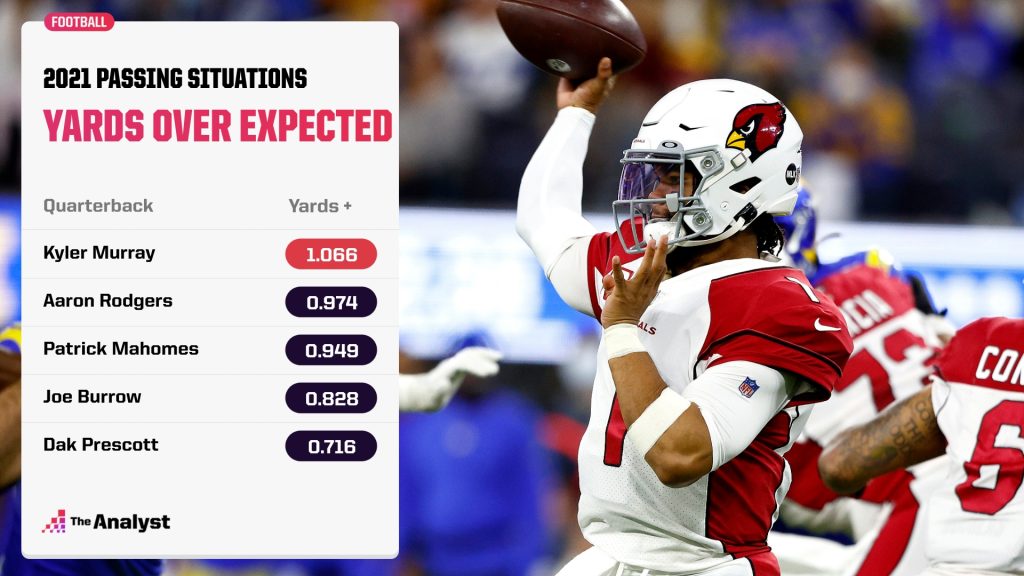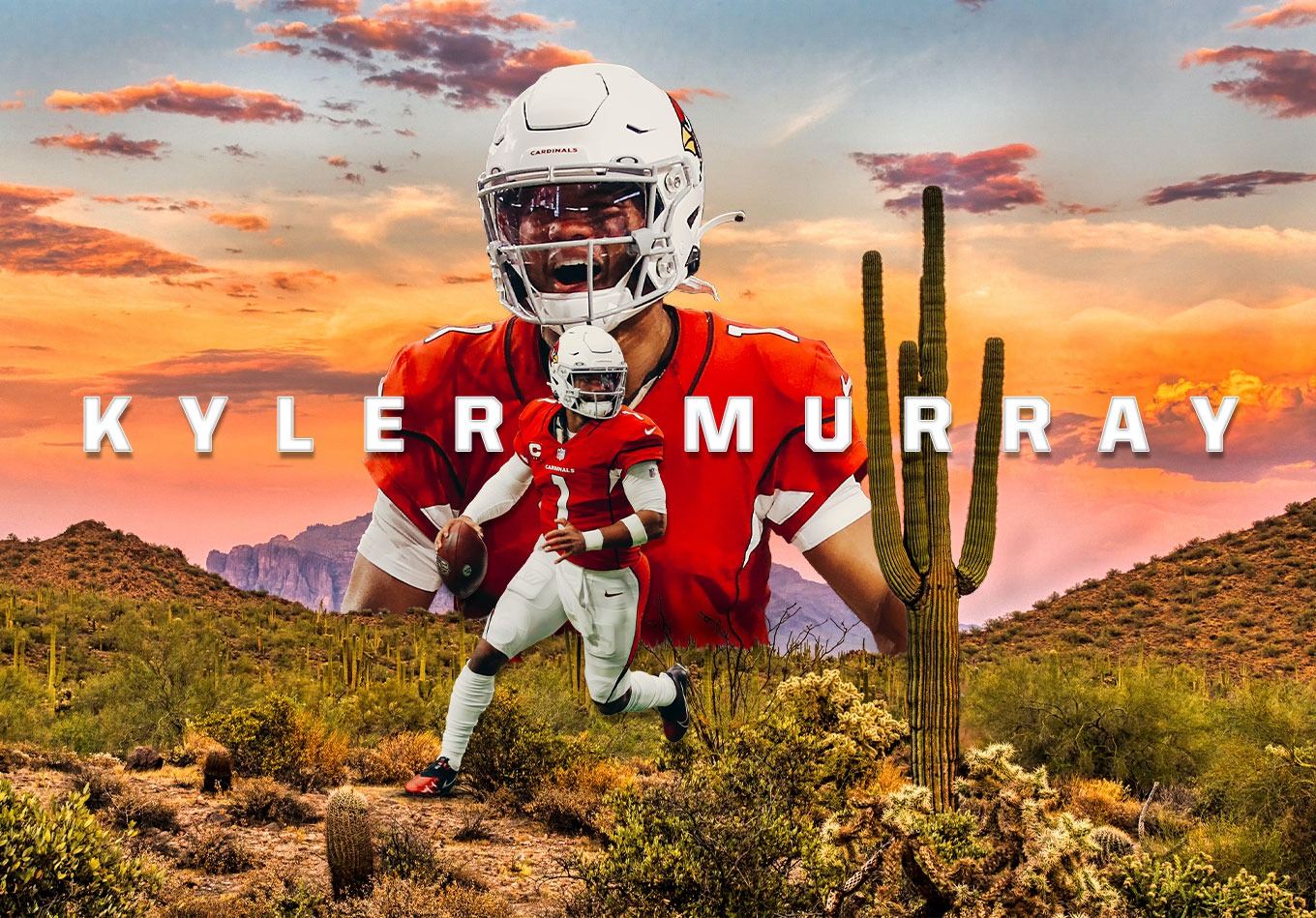Kyler Murray hasn’t won a playoff game, but leaving it at that is some shallow analysis. Look downfield and at his efficiency in passing situations, and it’s clear why the Arizona Cardinals paid him.
The Arizona Cardinals are one the most curious teams in the NFL. Defined in recent seasons by first-half surges followed by stretch-run slumps, a series of bemusing offseason roster moves have left many wondering as to the nature of the Cardinals’ plan of attack in an extremely difficult NFC West. What was always likely, however, was that plan including Kyler Murray.
Despite negotiations over an extension at times appearing tumultuous, a scenario in which Murray was not a part of the Cardinals’ future always seemed far-fetched.
So it proved last week when the Cardinals signed Murray to a five-year, $230.5 million extension, which sees him become the second-highest paid quarterback in the league with an average annual salary of $46.1 million.
Murray trails only Aaron Rodgers ($50.2 million) in that regard and becomes the latest quarterback to surpass $40 million a year in salary.
The Cardinals are in part paying for what they believe Murray can do in the future, now having seen him produce three seasons of play suggesting he has a chance to become one of the finest dual-threat quarterback in league history and lead Arizona to a long-awaited Super Bowl title.
But do his performances to this point, which have yet to deliver a playoff win, make him worthy of receiving more per year than all but the back-to-back defending MVP?
It is a question that grew more pointed with the news of an eyebrow-raising clause in Murray’s contract requiring him to complete at least four hours of “independent study” of material provided to him to prepare for a game.
That stipulation suggests Murray is not preparing at the level expected of a player receiving his salary. It’s difficult for anyone outside the Cardinals’ organization to know if that is the case, but we have analyzed the data from his three seasons in the NFL to see how his on-field performance compares to that of his contemporaries in the $40 million club.
Playing Catch-up in Basic Metrics
Seven other quarterbacks have recently signed contracts paying an average of at least $40 million: Rodgers, Deshaun Watson, Dak Prescott, Patrick Mahomes, Josh Allen, Derek Carr and Matthew Stafford.
Oversimplifying things, the first difference that stands out between Murray and this group is that all but one of the remaining quarterbacks on the list have won a playoff game – Derek Carr being the exception.
But a host of factors – including situation, injuries, and luck – go into determining such achievements. Wins are not a quarterback stat, but Murray is also in the bottom half of this group in most of the classic stats for players at the most important position.
Since entering the NFL as the first overall pick in 2019, Murray has racked up 11,480 passing yards. That tally puts him fifth among the $40 million club, with Mahomes, Carr, Rodgers and Allen the four quarterbacks to have amassed more in that period.
His completion percentage of 66.9 in that time also puts him fifth for that group of players, and he occupies the same spot in explosive passing plays of 25 yards or more (89).
Murray’s 70 passing touchdowns are fewer than all the $40 million quarterbacks other than Watson, who missed the entirety of last season. Allen (7.17) is the only one to have averaged fewer yards per attempt than Murray’s 7.26 and Stafford (2.3) is the sole quarterback of the group with an interception rate inferior to the Cardinals signal-caller’s 2.2%.
However, the days when such stats were the primary barometer by which quarterback performance was measured are gone, and Murray fares significantly better in metrics that gauge accuracy and efficiency.
Delivering Deep, and When it Matters
Murray made strides in delivering the ball accurately in 2021, as his performance in well-thrown rate illustrates. In 2020, Murray delivered an accurate, well-thrown ball on 76% of his passes, below the average of 78 for quarterbacks with at least 100 attempts. Last season, it improved to 78.5, though that still trailed Carr, Mahomes and Prescott.
Yet offense in the modern NFL is largely about generating explosive plays, and Murray thrives in an area that plays a critical role in a team’s success in doing so – deep accuracy.
The ability to throw downfield with pinpoint accuracy has long since been one of Murray’s calling cards, and last season his 62.5 well-thrown percentage on throws of 20 air yards or more was tied for seventh among quarterbacks with 20 such throws. He was tied with both Mahomes and Prescott and above every other quarterback in the club.
Explosive plays create efficiency, and the statistical impact of Murray’s deep-ball precision emphasizes that point.
Of the NFL’s highest-paid quarterbacks, only Carr and Stafford averaged more 20-yard passes per game than Murray (3.5) in 2021, while no quarterback in the NFL was more efficient in expected passing situations.
Murray ranked first in quarterback efficiency vs. expected. In expected passing situations, he averaged over a yard above expectation. No other quarterback in the league achieved that feat, with Rodgers (0.974) his nearest challenger:

That unmatched efficiency in the most important situations in an NFL game is worth the outlay the Cardinals have committed to Murray, and that’s before his running ability is even considered.
A Skillset Still to be Properly Harnessed
Murray’s dual-threat upside was a critical factor in his selection with the No. 1 overall pick three years ago. His is a skillset that meshes perfectly with the direction of modern NFL offenses, and his speed and elusiveness as a ball-carrier in the open field has unsurprisingly translated to the highest level.
Since 2019, Lamar Jackson (6.36) is the sole player in the NFL to average more yards per carry than Murray’s 5.69. No other quarterback earning $40 million plus per year averaged 5.5 yards per rush in that time, with Mahomes (5.30) and Allen (5.09) coming closest.
Allen (23) has scored more rushing touchdowns than Murray (20) over the last three seasons, and only Jackson has produced more explosive rushes of 20 yards or more across the same timeframe – the Baltimore Ravens superstar racking up 26 such runs compared to 15 for Murray.
That discrepancy is in part down to injury problems that forced Murray to miss three games last season and clearly affected him down the stretch of the 2020 campaign.
Durability is undoubtedly a concern that arguably makes handing such a contract to Murray a risk, while there is also a case to be made he is overly reliant on All-Pro wide receiver DeAndre Hopkins. With Hopkins in the lineup last season, the Cardinals racked up 7.81 yards per pass play. In the seven games he missed, they averaged 5.86.
Yet those struggles were as much about Kliff Kingsbury’s use of personnel as they were about Murray. Kingsbury insisted on using Hopkins almost exclusively as an outside receiver – where he played 475 of his 537 snaps in 2021 – and the Cardinals had nobody to fill the void on downfield routes from that spot when he was injured. Arizona averaged 6.84 air yards per completion with Hopkins and just 4.35 when he was sidelined.
While the bizarre clause in Murray’s contract indicates he needs to do more during the week to realize his potential, Kingsbury must also make significant improvements.
Arizona’s offense has been too focused around Hopkins and Murray’s success in improvization – as their league-leading 1.72 yards over expected on runs in expected passing situations points to – and the onus is on Kingsbury to develop a more diverse gameplan to make the most of the incredible quarterback talent he has at his disposal.
Murray’s résumé may not yet compare to several of the highly paid contemporaries whose salaries he has now surpassed. However, he’s a quarterback who has improved year on year in more rudimentary metrics such as completion percentage, touchdown percentage and passing yards per game, with his increased accuracy and deep-ball prowess that only Mahomes and Prescott can match helping Murray become the league’s most efficient quarterback in high-pressure obvious passing situations.
The baseball prospect turned football star confounds defenses by excelling when they know what to expect and delivering the unexpected with remarkable consistency.
Few players can replicate his ability to do both with such regularity. If properly harnessed by the Cardinals, Murray has the chance to reach a ceiling at the very top of the NFL and individually compare much more favorably with a group of quarterbacks who in some cases have already enjoyed the success to which he aspires.
Banner graphic by Matt Sisneros.
Enjoy this? Subscribe to our mailing list to receive exclusive weekly content.
